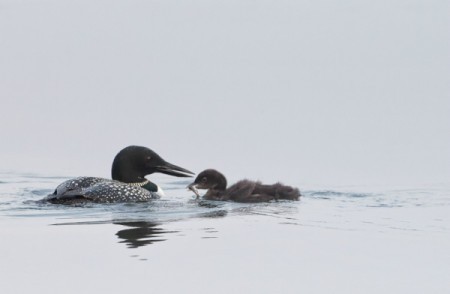
 The Common Loon, Gavia immer, makes its home primarily in North America, but can also be found in Greenland and Iceland, and occasionally in Europe and Asia. In North America, Canada is the epicenter of the common loons breeding range, hosting as many as a half million breeding pairs. Outside of Alaska, common loons are actually not that common in the United States. Although a handful of states can claim a few hundred birds each, Minnesota leads the way, providing homes to 12,000 or more adult loons during the summer. Other large populations reside in Wisconsin and Maine, each hosting several thousand breeding pairs during the summer.
The Common Loon, Gavia immer, makes its home primarily in North America, but can also be found in Greenland and Iceland, and occasionally in Europe and Asia. In North America, Canada is the epicenter of the common loons breeding range, hosting as many as a half million breeding pairs. Outside of Alaska, common loons are actually not that common in the United States. Although a handful of states can claim a few hundred birds each, Minnesota leads the way, providing homes to 12,000 or more adult loons during the summer. Other large populations reside in Wisconsin and Maine, each hosting several thousand breeding pairs during the summer.

Loons have several specialized characteristics to help them master life on the water.
Even their name suggests that these birds are ill-suited to life on land. The word Loon is derived from the Scandinavian word lom, meaning lame or clumsy, and is a direct reference to the lumbering, awkward way that they stumble around on land. Rarely do loons come to land other than to nest.
Although strong leg muscles and webbed feet work well in the water, the position of their legs so far back on the body hinders their ability to walk and fly. Although adult loons are able to hold their body off the ground when on land, they shuffle along clumsily with their breast dragging on the ground.
To take flight, they need a long runwayas much as ¼ mileand they need to take advantage of wind direction. Once airborne, the loon has to flap its small wings around 275 beats a minute to keep its large body aloft. This propels them across the sky at speeds upwards of sixty miles per hour.
The Common Loon has two different sets of plumage. The flashy one, and the one that most people are familiar with from pictures, is worn for the breeding season (March to October). Its called the alternate or nuptial plumage and consists of a glossy black head, white necklace, and a black and white checkerboard back. The other is worn during the winter and is called basic plumage.
In winter, Common Loons have dark feathers on their back, the top of their heads, and back of their necks. The belly, front of the neck, and chin area are white. In short, they take on a drab, gray appearance. In January, loons drop all of their flight feathers and grow them back in February and March. Although this leaves them flightless while on the ocean (where they spend winters) there are really no reasons to fly anyway. Young loons sport the drab gray basic plumage until they are about four years old, when they acquire their breeding plumage for the first time.
A typical life in the day of a Common Loons consists of preening (cleaning and water-proofing its feathers), resting, finding things to eat, and socializing with other loons.
Loons have an oil gland at the base of their tail that is used to waterproof their feathers. Squeezing the gland with the bill causes oil to be released. When the feathers are passed through the bill, they get a coating of oil which makes them more water repellant.
Loons are sight feeders. They lower their heads into the water (peering) as they swim and when they see something they want to pursue, they dive. The average length of a feeding dive is less than a minute, but they have the ability to stay underwater for as long as five minutes. They eat mostly fish, crayfish and a variety of aquatic invertebrates.
Common loons give five basic calls: the hoot, wail, tremolo, yodel (made by adults) and the peep (made by chicks begging for food). Interestingly, the calls are reserved for communication during the summer/breeding season. In the winter months, loons are almost entirely quiet.
The hoot is the simplest loon call consisting of one short note. Hoots are the most common call given when groups of loons are interacting peacefully.
The wail is a long, drawn-out call that sounds like a wolf howling. It has a mournful quality, but in reality it is used to bring two loons that are far apart closer together.
The tremolo is the staccato set of high and low notes and sounds like a crazy laugh. Scientists think it serves as an alarm, as the loons giving a tremolo usually move away from a disturbance.
Yodels are given during territorial encounters, usually between two males. One or both will yodel until one quits and goes away or the encounter escalates into a physical fight.
Loon chicks peep when they are begging for food. The peeps are sometimes accompanied by pecks to the bill, neck, or head of the parent.
Most loons return to the same breeding lake (and same nests) year after year, however, not always with the same mate. Having the same mate is more of a by-product of both sexes returning to the same lake independently. The male arrives first, and the female 7 to 10 days later.
Lakes selected for breeding must be large enough for take-offs and landings, have a good food supply (and clear water to see prey), a suitable shoreline or island for nesting, and a stable water level during the nesting period.
Nesting sites are always close to the waters edge, and if possible, near deep water. Loons prefer small islands as nest sites because they are safer from predators on land like skunks and raccoons.
Once the nest is made, the female lays one, two, or very rarely three eggs. Two is the normal clutch size for loons in their first nesting attempt of the year. The eggs are laid one at a time over the course of two or three days. The female begins incubating them as soon as the first one is laid so that one egg is always a day or so ahead of the other in development. Both the male and female share incubation duties.
Many of the first nesting attempts fail from predators, weather, etc. As a result, loons have adapted the ability to re-nest (produce a second set of eggs, sometimes even a third). Re-nest attempts are often in a different nest and usually consist of only one egg. A breeding pair will only attempt to re-nest when a nest is destroyed, not if the chicks hatch but die later.
Eggs hatch about 28 days after incubation. After hatching, loon chicks are taken to nursery areas on the lakesheltered areas that have an abundance of food. When two eggs hatch, the loon chicks will engage in pecking battles the first few days after hatching. The older, stronger, and first-to-hatch chick usually wins, which gives it first dibs on the food. As a result, the outranked chick slowly weakens and often dies by the fifth or sixth week of development.
Chicks are allowed to ride on the adults back until they reach 17 to 21 days old. This reduces chilling and loss from predators. By eight weeks they have nearly reached their adult size and will take their first flight at ten to 12 weeks old. The group remains a family only during the three to four months of summer.
The Common Loon migrates south to open water for the winter. Some overwinter inland on lakes, rivers, and reservoirs. Other hardy birds will choose to ride out the winter swells on the Great Lakes. Most, however, take up residence in the warmer coastal waters of the south and southeastern U.S. They gather in large groups, stopping to feed along the way.
Young loons start their fall migration several weeks after the adults leave and are left alone to find their way.
Every year, there are loons that dont leave soon enough and are trapped by fast forming ice. Autumn is when some the highest mortality occurs in loon populationsdepletion of energy stores during flight, outbreaks of disease, and injuries from attempting to land on shiny, wet roads and highways that look like rivers.
Add your voice! Click below to comment. ThriftyFun is powered by your wisdom!
My family built a small resort on a beautiful, clear-water lake in Itasca County, MN, beginning in 1948. We were entertained every summer by 'Loon-Song', which was especially ethereal at sunset and after dark. Your article didn't miss anything I've learned of loons -- good on you!
The state of Minnesota has provided floating (anchored) platforms to make nesting safer for loons. And, has set up video cameras in certain areas. It's also against the law to harass them; don't try it if there are witnesses! You'll be challenged.
Readers may be able to find camera nesting sites by Googling.
Add your voice! Click below to comment. ThriftyFun is powered by your wisdom!